MSI Stealth 18 AI Studio review: A big laptop with a big price tag
- Thin and light for an 18-inch laptop
- Vibrant 18-inch Mini-LED display
- Excellent sound system
- Wired connectivity includes Thunderbolt 4, 2.5Gbps Ethernet
- Design, fit-and-finish needs work
- CPU, GPU performance doesn’t match competitors
- Battery life is short, though better than some alternatives
- Low value for money
MSI’s Stealth 18 AI Studio A1V has a beautiful display and lots of connectivity, but high pricing paired with mediocre performance (for its size, at least) leaves it behind the pack.
Price When Reviewed$4,199.99
Best Prices Today: MSI Stealth 18 AI Studio Retailer Price $4199.99
View Deal
Price comparison from over 24,000 stores worldwide
Product
Price
Price comparison from Backmarket
$4199.99
View Deal
Price comparison from over 24,000 stores worldwide
Product
Price
Price comparison from Backmarket
Big laptops are back in style, and the largest have glorious 18-inch, 16:10 aspect ratio displays that feel barely smaller than a typical desktop monitor. The MSI Stealth 18 AI Studio is one such laptop, and it attempts to stand out by shaving a few pounds and reducing its profile to under an inch thick. These efforts do result in a lighter, more portable 18-inch powerhouse, but the laptop’s design, build quality, and overall performance fail to justify its high price.
Further reading: Best laptops for video editing 2024: Work faster with these expert picks
MSI Stealth 18 AI Studio: Specs and featuresThe MSI Stealth 18 AI Studio A1V boosts hardware typical of a top-tier laptop including an Nvidia RTX 4090 GPU, a 4K display, 64GB of RAM, and a 2TB solid state drive. It also has excellent network connectivity with support for 2.5Gbps Ethernet and Wi-Fi 7.
- CPU: Intel Core Ultra 9 185H
- Memory: 64GB LPDDR5
- Graphics/GPU: Nvidia RTX 4090 with up to 150 watt TGP
- NPU: Intel AI Boost
- Display: 3840×2400 16:10 aspect ratio Mini-LED IPS 120Hz
- Storage: 2TB PCIe 4.0 NVMe M.2 solid state storage
- Webcam: 1080p 30fps camera with HDR and IR 3D camera for Windows Hello
- Connectivity: 1x Thunderbolt 4, 1x USB-C 3.2 Gen 2, 2x USB-A 3.2 Gen 2, SDcard reader, x HDMI 2.1, 1x 2.5Gbps Ethernet (RJ45)
- Networking: Wi-Fi 7, Bluetooth 5.4
- Biometrics: Windows Hello facial recognition, fingerprint reader
- Battery capacity: 99 watt-hours
- Dimensions: 15.74 x 11.4 x 0.94 inches
- Weight: 6.37 pounds
- MSRP: $4,199.99
However, one specification stands out as a potential issue: the Intel Core Ultra 9 185H processor. Most larger laptops sold above $4,000 have an Intel Core i9-14900HX, which offers more processor cores and can draw more power.
The model I received to review has an MSRP of roughly $4,200, which is extremely expensive. MSI offers a less expensive model with an RTX 4080, 32GB of RAM, and 1TB solid state drive for $3,300.
The MSI Stealth 18 AI Studio is passable, but the alternatives deliver far more value for your money.
MSI Stealth 18 AI Studio: Design and build quality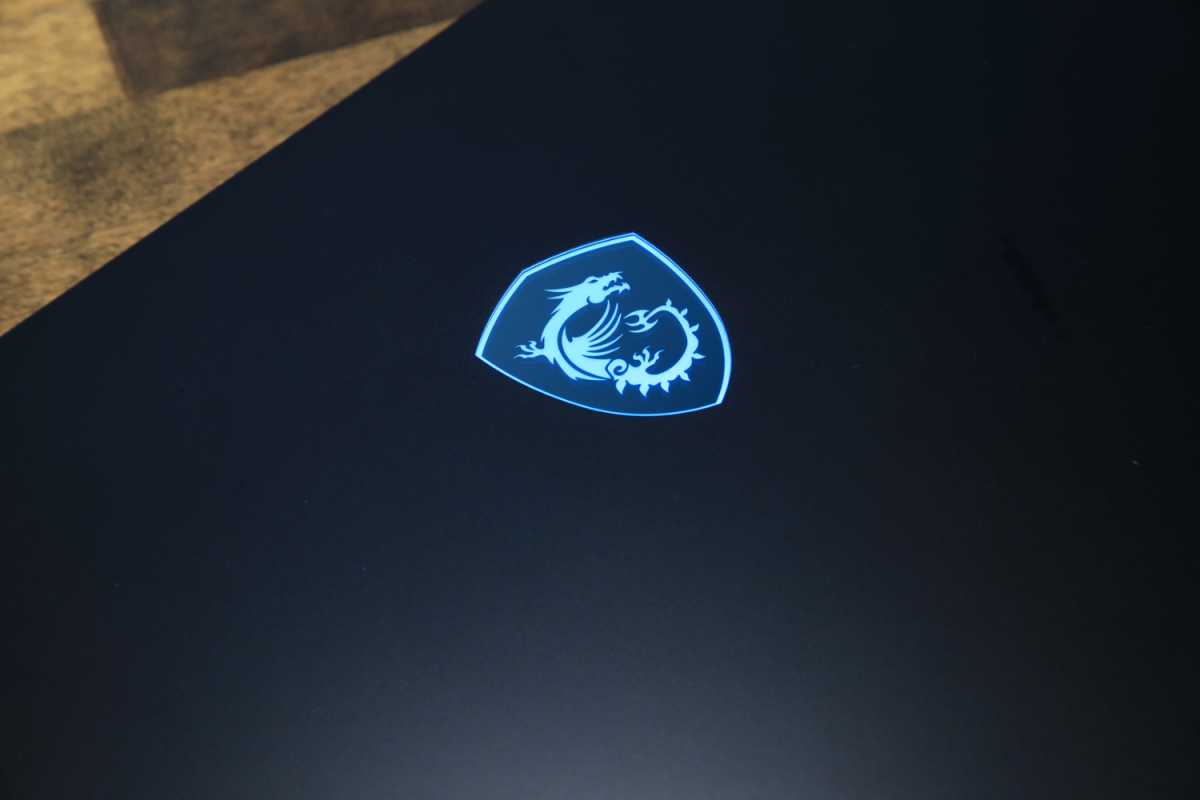

IDG / Matthew Smith

IDG / Matthew Smith
IDG / Matthew Smith
A laptop as expensive as the MSI Stealth 18 AI Studio sets a high standard for itself. Not only must the hardware be top-notch, but the exterior must appear attractive and luxurious. Unfortunately, the Stealth 18 AI Studio fails to meet this standard.
MSI’s Stealth lineup tries to offer professionals and gamers a slimmer, lighter alternative to workstation and gaming laptops. To achieve this, MSI opts for a magnesium-aluminum alloy chassis, which keeps the laptop’s weight under 6.4 pounds.
But while magnesium-aluminum delivers durability and low weight, it’s not rigid and feels like plastic when touched. As a result, the Stealth 18 AI Studio would seem mediocre even with a $2,000 price tag. At $4,200—not far off a Razer Blade 18—it’s hard to understand what MSI was thinking.
Build quality did not impress. Handling the Stealth caused a variety of creaks, groans, and snaps as various panels flexed and shifted. The most unfortunate of these repeatedly occurred when I removed my right hand from the palm rest. Apparently, the weight of my hand was enough to slightly deform the panel, causing it to snap back into place when I lifted my hand.
That’s disappointing for a laptop that costs north of $4,000. But the laptop’s problems begin even before you touch it. Compared to alternatives like the Razer Blade 18 or Dell XPS 16, the Stealth looks generic and unappealing. A couple of RGB-LED accents are its only attempt to add flair, and they don’t do enough to make the laptop stand out.
It’s a shame, because it’s not as if MSI can’t execute on design. The MSI Titan 18 HX, which I reviewed earlier in 2024, is a gorgeous laptop that looks distinct and feels sturdy. Unfortunately, MSI’s effort to make the Stealth thinner and lighter results in a compromised design.
MSI Stealth 18 AI Studio: Keyboard, trackpad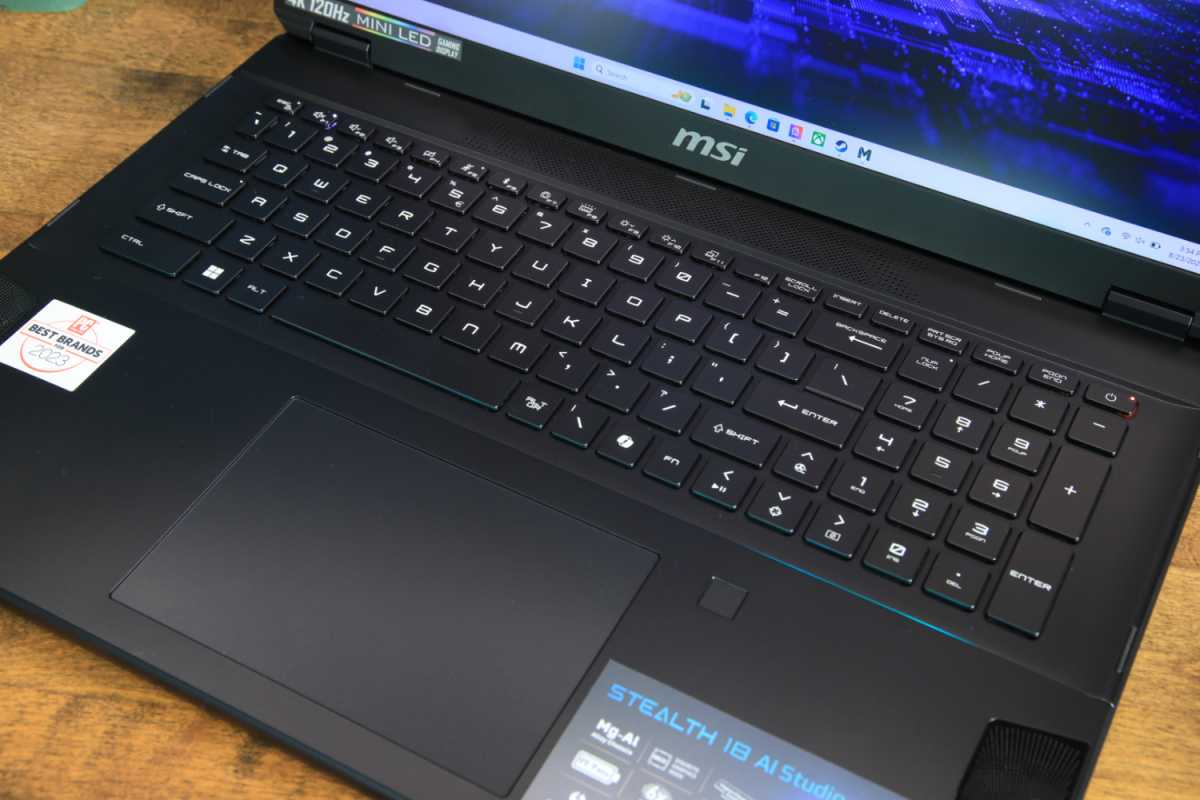

IDG / Matthew Smith

IDG / Matthew Smith
IDG / Matthew Smith
The MSI Stealth 18 AI Studio’s keyboard is better than its overall design, but it’s still mediocre for the price.
Upon opening the laptop, you’ll find a spacious keyboard with a number pad. Nearly all keys are full-sized, including the numpad keys, which is unusual even for an 18-inch laptop. Only a few keys, like the right-side shift key, are noticeably reduced in size. The keyboard is immediately comfortable and intuitive to type on.
Key feel is acceptable. Each key has respectable travel and bottoms out with a definitive action. However, there’s nothing about the experience that’s worthy of the laptop’s high price tag. It’s not a mechanical keyboard and lacks unique knobs, dials, or macro keys. It does have customizable RGB backlighting, but that feature is common among laptops that cost a couple of thousand dollars less.
The touchpad continues the trend of adequate features that don’t live up to the price. It’s smooth and responsive, but it measures about five and a quarter inches wide by three and a half inches deep, which isn’t large for an 18-inch laptop. Many competitors like the Razer Blade 18, Dell XPS 16, and Apple’s MacBook Pro 16, offer much larger touchpads. The touchpad also doesn’t support haptics, which is a common feature at this price point, though also missing from competitors like the Razer Blade 18.
MSI Stealth 18 AI Studio: Display, audio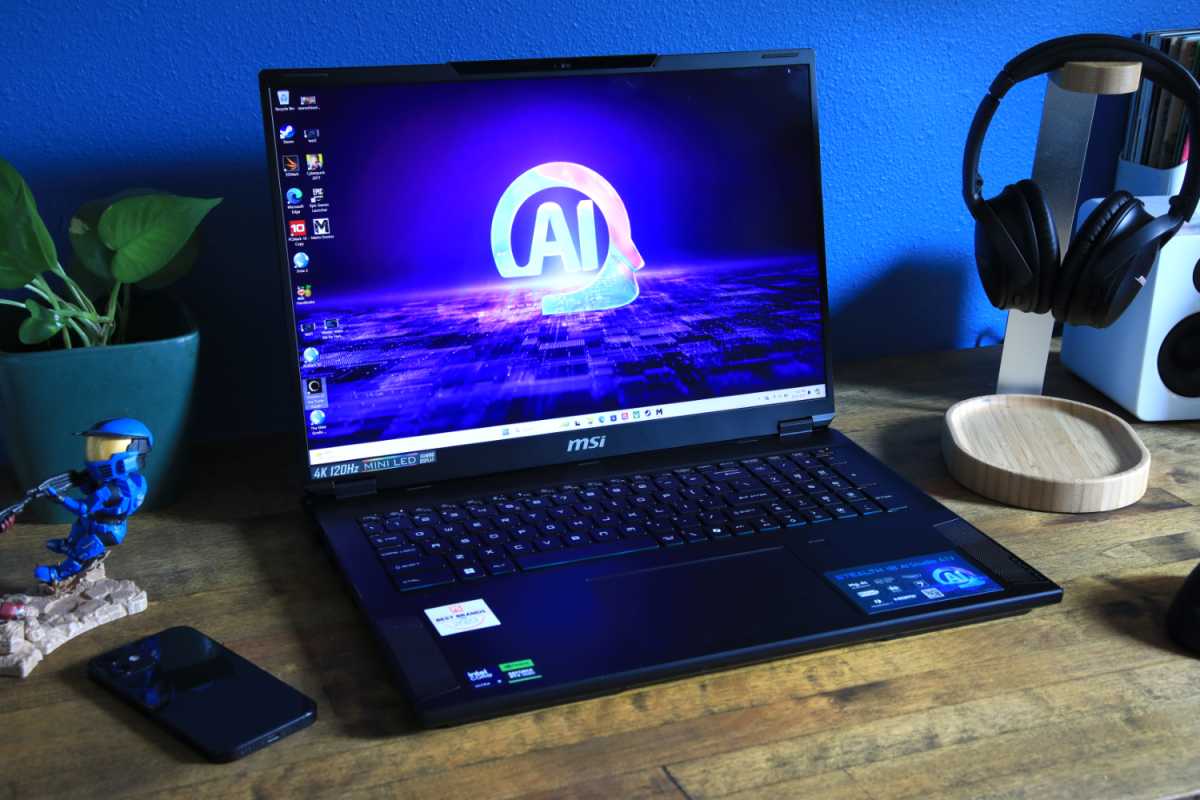

IDG / Matthew Smith

IDG / Matthew Smith
IDG / Matthew Smith
One feature that does feel worthy of the MSI Stealth 18 AI Studio’s high price is the display. The Stealth has an 18-inch, 16:10 aspect ratio display with a resolution of 3840×2400. It also has a Mini-LED backlight, a technology also found on laptops like the Apple MacBook Pro 16 and Lenovo Yoga Pro 9i, promises excellent color performance and high brightness alongside contrast that rivals, if not equals, OLED.
MSI’s display delivers on that promise. It’s exceptionally bright when turned up to full brightness and offers a great experience in HDR content. The panel also has a matte finish instead of a glossy one, so it better handles glare from windows or lamps positioned behind you. Color performance is excellent too, with spot-on color accuracy and a wide color gamut suitable for creative work. This helps the display look vibrant and saturated in your favorite movies or games.
Contrast can match OLED to provide a great sense of immersion and depth, but with a caveat. Mini-LED displays break up the backlight into LED lighting zones, which turn on and off individually, much like the pixels on an OLED display. Because of this, the display can achieve a perfect minimum brightness of zero nits.
However, the backlight zones are much larger than individual pixels, which can cause a problem known as blooming when a bright object is shown on a dark background or vice versa. For example, if you’re watching a dark scene in a movie with subtitles on, you may notice a glow or halo around the subtitles.
The Stealth’s speakers are another highlight. MSI pairs upwards-firing speakers with internal woofers to deliver balanced, voluminous sound that doesn’t change depending on the surface the laptop is set on. Audio quality is good enough that many less critical listeners will see no need to connect external speakers, and the laptop can fill a small room with music during your 9-to-5.
MSI Stealth 18 AI Studio: Webcam, microphone, biometricsThe MSI Stealth 18 AI Studio ships with a typical 1080p webcam capable of capturing video at up to 30 frames per second. Most modern laptops sold above $1,000 ship with a similar webcam, so the Stealth has no advantage here. Still, it’s a respectable camera with decent sharpness and color reproduction. The same can be said of the microphone array, which captures clear, crisp audio with minimal background noise.
MSI doesn’t skip the biometrics. It supports Windows Hello with both a fingerprint reader and facial recognition. The fingerprint reader is not in the power button, as is true of many laptops, but instead beside the touchpad. I prefer this, since it means there’s no chance of accidentally putting the laptop to sleep while trying to log in.
MSI Stealth 18 AI Studio: Connectivity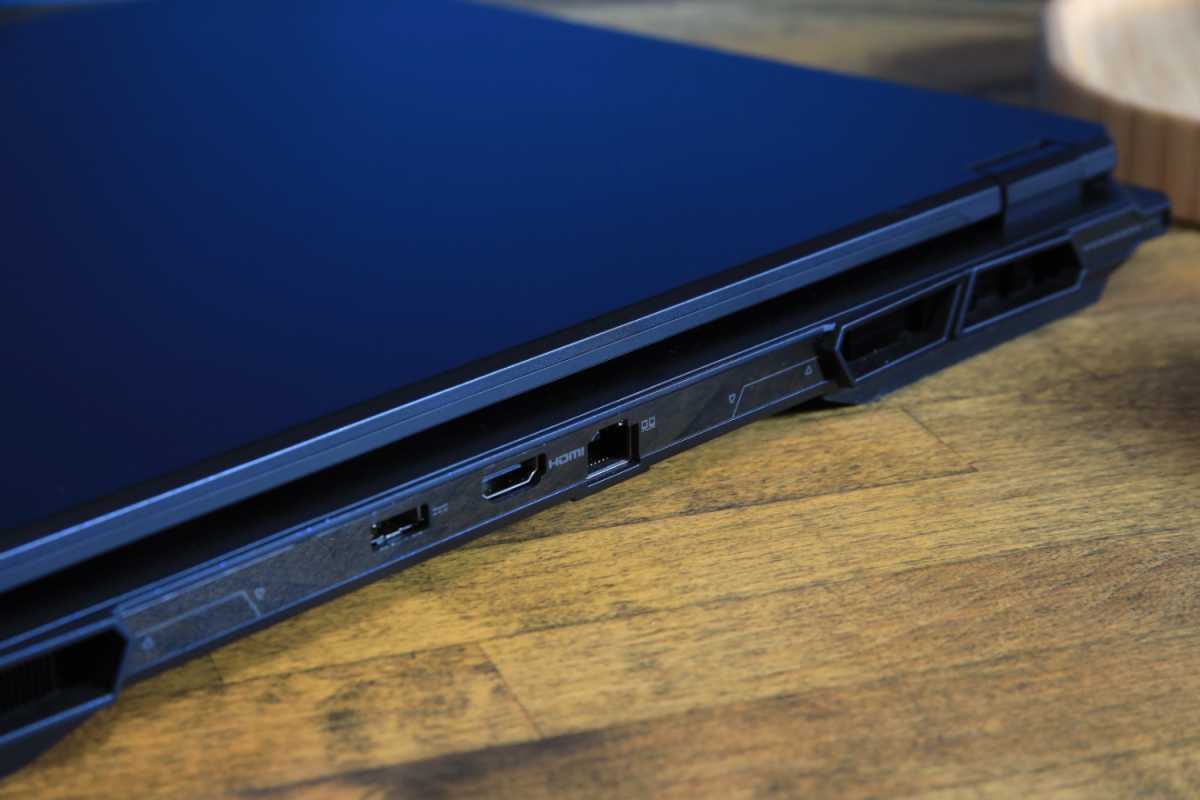

IDG / Matthew Smith

IDG / Matthew Smith
IDG / Matthew Smith
MSI distributes ports across three sides of the Stealth 18 AI Studio A1V. The right flank houses the Thunderbolt 4 and USB-C port, while the left flank has two USB-A ports. Around back is HDMI 2.1, 2.5Gbps Ethernet, and a rectangular port for the 280 watt power adapter. An SD card reader and 3.5mm combo audio jack round out the options.
This is a solid range of connectivity, though it may depend on your perspective. If you’re considering the Stealth 18 AI Studio against thin and light performance laptops, like a Razer Blade or Dell XPS, the Stealth’s connectivity is great. But if you’re considering gaming laptops, like a Gigabyte Aorus or Acer Predator Helios Neo, the Stealth’s ports are par for the course.
Wireless connectivity is strong, as well, with support for Wi-Fi 7 and Bluetooth 5.4. These are the latest versions of each wireless standard, so the laptop’s wireless connectivity is as future-proof as any laptop sold in 2024 can be.
MSI Stealth 18 AI Studio: PerformanceThe MSI Stealth 18 AI Studio A1V’s pricing is most obviously justified by the hardware. It packs an Intel Core Ultra 9 185H processor, Nvidia RTX 4090, 64GB of LPDDR5 memory, and a 2TB PCIe 4.0 solid state drive. This is powerful hardware, but the Intel Core Ultra 9 185H is an unusual choice for a laptop in this size and price category: many opt instead for the Intel Core i9-14900HX.
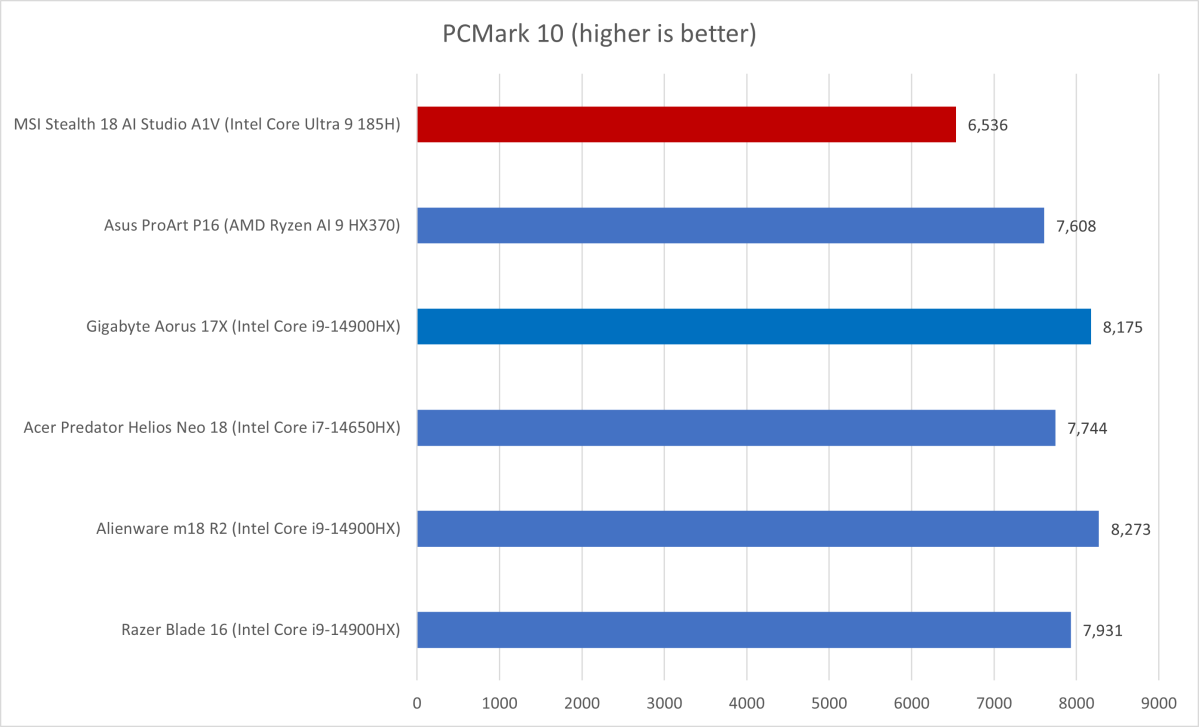

IDG / Matthew Smith

IDG / Matthew Smith
IDG / Matthew Smith
PCMark 10, a benchmark meant to represent a wide variety of common productivity tasks, puts the MSI Stealth 18 AI Studio A1V off to a bad start. Although its score of 6,536 isn’t bad, it’s not up to the standard set by competitive laptops, some of which can exceed a score of 8,000 in this benchmark.
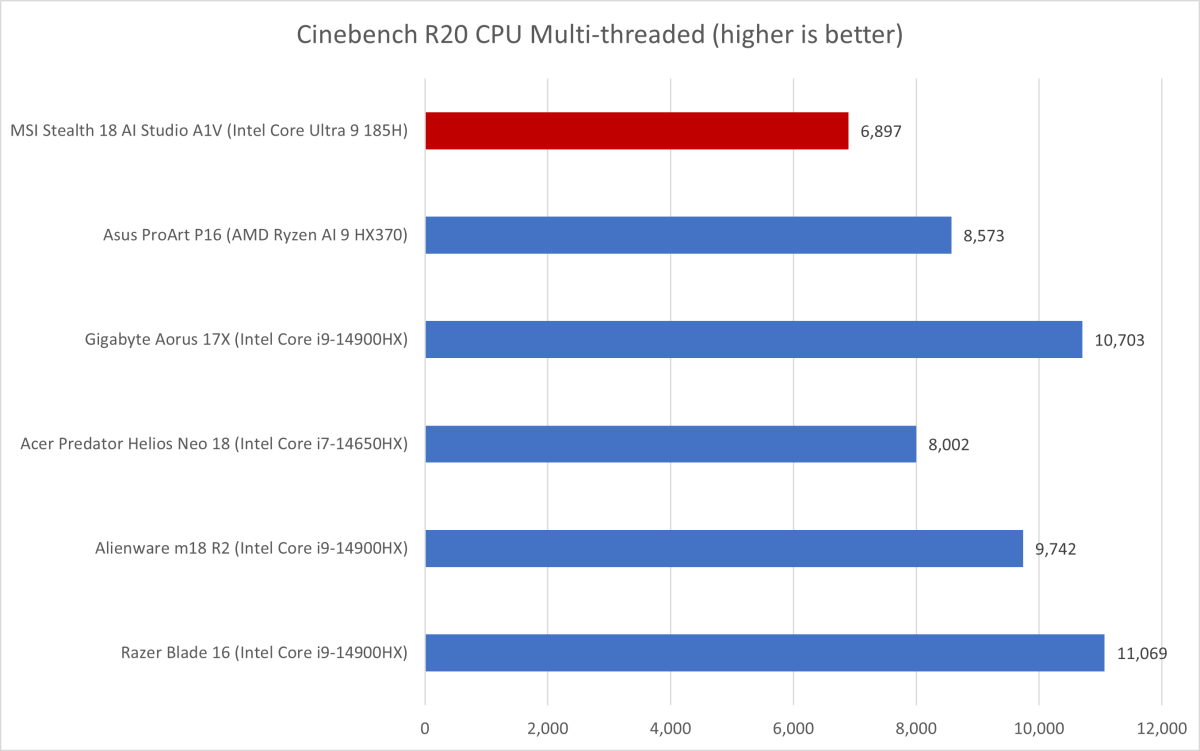

IDG / Matthew Smith

IDG / Matthew Smith
IDG / Matthew Smith
Next up is Cinebench R20, a short-duration, heavily multithreaded benchmark. It once again placed the MSI Stealth 18 AI Studio A1V behind the competition with a reasonable but unimpressive score of 6,897.
The reasons for this aren’t too hard to guess. The Intel Core Ultra 9 185H has a respectable 16 cores, but that’s far less than the Intel Core i9-14900HX, which has a total of 24 cores. The Core i9-14900HX can consume more power, too, further boosting performance.


IDG / Matthew Smith

IDG / Matthew Smith
IDG / Matthew Smith
The Stealth again falls behind in Handbrake, a heavily multi-threaded, long duration benchmark which encodes a two hour long, 1080p movie from MP4 to MKV. However, the Stealth notches a win over the Asus ProArt P16, which had an AMD Ryzen AI 9 HX 370. That isn’t a major surprise, as we’ve noticed Intel processors tend to outperform AMD processors in these benchmark.
Clearly, the Stealth’s decision to use the Intel Core Ultra 9 185H has consequences. That doesn’t come as a shock, because the Intel Core Ultra 9 185H occupies a lower tier in Intel’s product performance stack than does the Intel Core i9-14900HX. With fewer cores and a lower design power, the Core Ultra 9 185H isn’t designed to keep up with its more power-hungry sibling. However, this is yet another area where the Stealth doesn’t live up to its price.
The GPU could be a different story. The Stealth we tested had an Nvidia RTX 4090 with a maximum graphics power of 150 watts. That could, in theory, give the Stealth enough graphics grunt to wrangle with the competition.
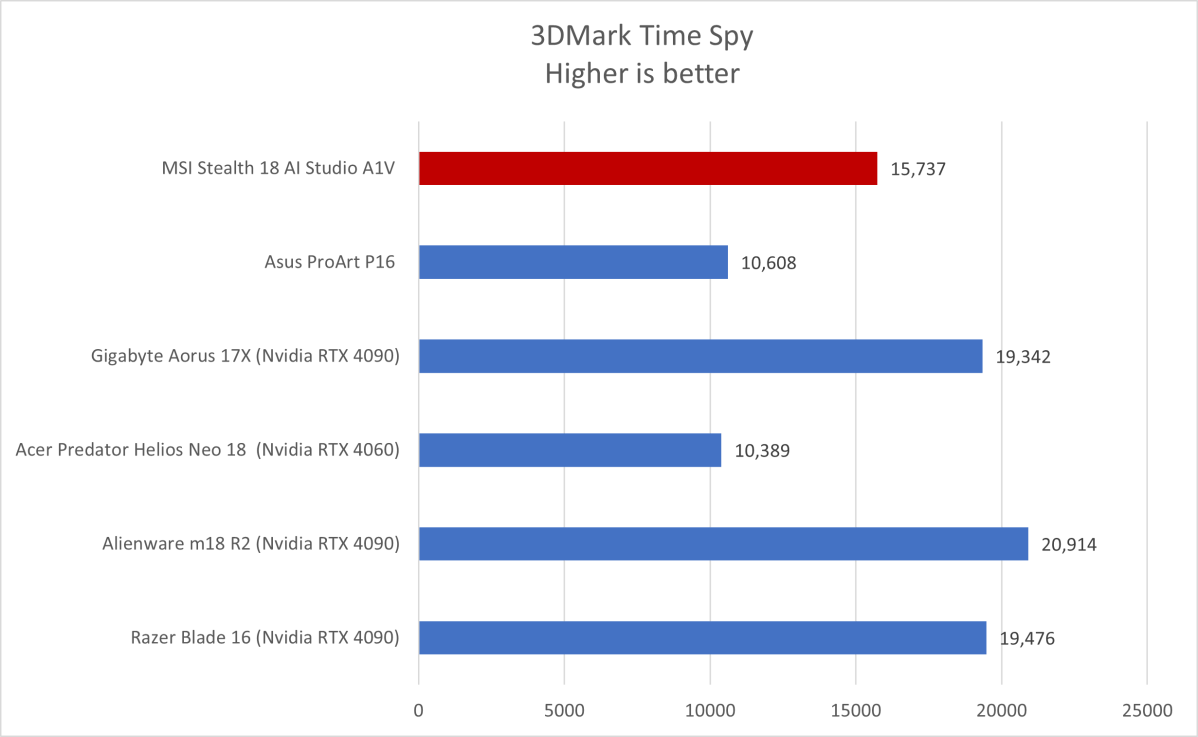

IDG / Matthew Smith

IDG / Matthew Smith
IDG / Matthew Smith
Unfortunately, 3DMark Time Spy puts that theory to the test and finds the Stealth wanting. While a 3DMark Time Spy score of 15,737 is strong, it’s not able to compete with many other laptops that equip Nvidia RTX 4090 graphics.
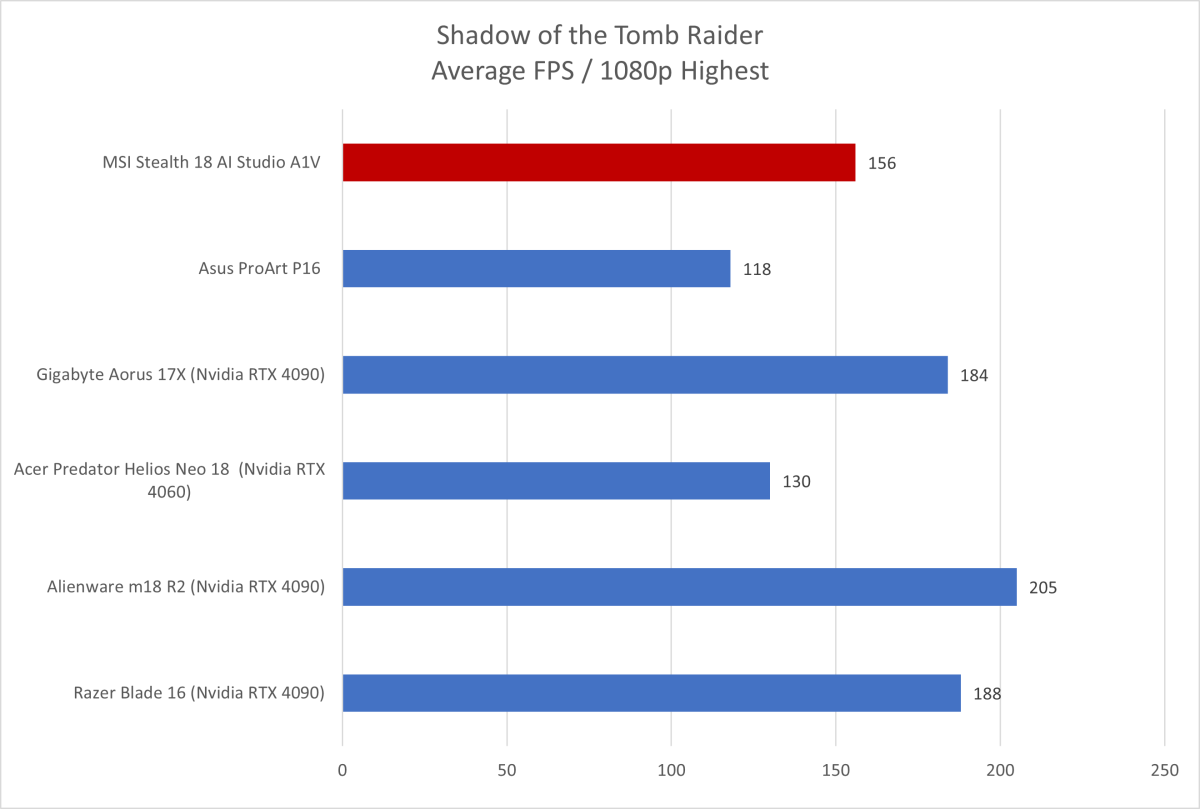

IDG / Matthew Smith

IDG / Matthew Smith
IDG / Matthew Smith
Shadow of the Tomb Raider, though now an older game, remains representative of games from the PlayStation 4 and Xbox One console generation. Unsurprisingly, the Stealth handled this game with ease and achieved a frame rate average above 150 frames per second. But, once again, the Stealth’s performance falls behind other laptops with Nvidia RTX 4090 graphics.
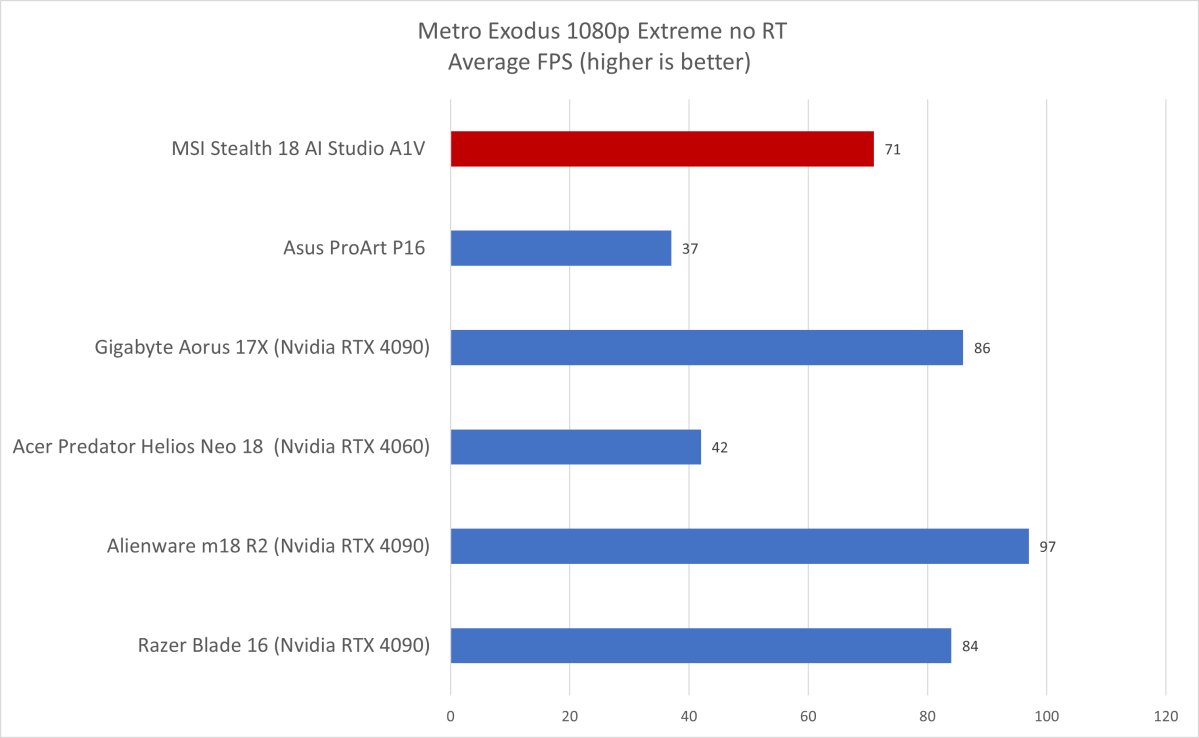

IDG / Matthew Smith

IDG / Matthew Smith
IDG / Matthew Smith
Metro Exodus is more of a cross-gen title, though in this benchmark we run it without ray tracing on. Even so, the game’s Extreme preset is incredibly demanding, and so the mighty RTX 4090 turns in a mere 70 frames per second. Enjoyable, to be sure, but once again behind similar laptops.
I wrapped up testing with Cyberpunk 2077, which remains among the most visually attractive and feature-rich PC games available. The Stealth averaged 96 frames per second at 1080p resolution and the Ultra preset with all forms of resolution scaling and frame generation turned off. That’s great, but the Razer Blade 16 with RTX 4090 was a bit quicker with an average of 100 frames per second.
For an even more demanding test I switched to Cyberpunk 2077’s Ray-traced Overdrive preset. Here the Stealth averaged just 32 frames per second. That’s actually a good result for the game at this preset on laptop hardware, but the Razer Blade 16 was again quicker, as it averaged 38 frames per second.
All of the results above were reached with the Stealth in Balanced profile (this is true, also, for the competitive laptops we tested), which is the default. I also tested the laptop in the Extreme Performance preset, which boosted performance by five to 10 percent. That might be important in some tasks, but in general, the Extreme Performance profile did not change the narrative on the Stealth’s performance.
Fan noise was at times an issue. I noticed that the laptop has a tendency to cycle between two fan speeds when at idle or in less demanding apps, which was annoying. In more demanding apps, and especially with Extreme Performance mode on, the laptop’s fans became a constant companion. That’s also true of the Stealth’s competitors, but it’s worth keeping in mind if you think silence is golden.
Oh, and what about AI? Despite its name, the MSI Stealth 18 AI Studio A1V doesn’t offer any unique AI features, and it lacks a high-performance NPU like that found on more recent AMD Ryzen AI and Qualcomm Snapdragon X chips.
MSI Stealth 18 AI Studio: Battery lifeThe MSI Stealth 18 AI Studio A1V is listed with a 99.9 watt-hour battery. Windows, however, reported the watt-hours at roughly 97 watt hours. It’s a large battery, but the Stealth ultimately fails to improve on the awful battery life that large, powerful Windows laptops are known for.


IDG / Matthew Smith

IDG / Matthew Smith
IDG / Matthew Smith
Our standard battery test, which loops a 4K file of the short film Tears of Steel, sucked the Stealth dry in about five hours. That is better than some alternatives, like the Razer Blade 16 and Alienware m18 R2, but it’s still not a great result.
With that said, I’ll give the Stealth this much: its battery life is at least usable. I took the Stealth on a couple two-hour long trips to the coffee shop and found that, while writing and browsing the web, the battery would last just as long as the video test suggests, which meant I still had well over half a full charge left by the time I wrapped up my work.
MSI Stealth 18 AI Studio: ConclusionMSI’s Stealth 18 AI Studio A1V has its virtues. It’s a large laptop with a big, vibrant Mini-LED display, decent keyboard, and lots of connectivity. The Stealth is also thinner and lighter than most 18-inch laptops.
However, the Stealth’s retail price of $4,200 feels excessive. It’s more expensive than a similarly equipped Alienware m18 R2, and only a couple hundred less than a similar Razer Blade 18. Both alternatives are far more attractive and beat the Stealth in performance. That leaves MSI’s 18-incher in a tough spot. It’s passable, but the alternatives deliver far more value for your money.
